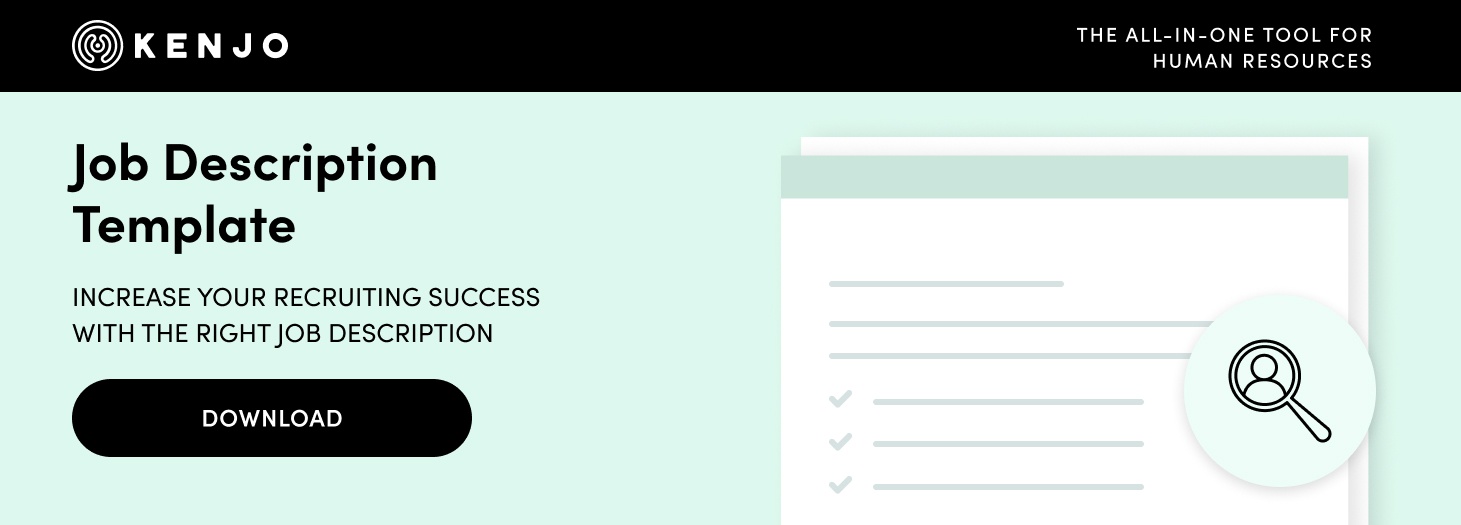The job description provides the blueprint for the recruitment process, setting out the expectations and requirements of the role for potential candidates. So, taking time to craft an accurate description helps to filter out unsuitable applications and streamline the process.
Here we explain more about why a good description is important, how you should structure a job profile and some writing tips to help along the way.

What is a job description?
The definition of a job description is a document designed to provide job candidates with an overview of what a specific position involves.
Generally, it contains text or a list detailing all the position’s duties and responsibilities. It describes the expertise, characteristics, skills, or attitudes people applying for the job need to possess, as well as the role’s mission within the business strategy.
The Human Resources department – or the person in charge of the recruitment process – has responsibility for completing the job role analysis and description.
The importance of a good job description
With up-to-date and correct information, candidates can decide if their abilities match a company’s requirements and whether it is a job they really want to do. This makes the job description an essential element of a company’s staff selection process.
From the organisation’s point of view, an accurate job description is vital to ensure applications match the requirements of the post. When the HR department only has to deal with the most qualified candidates it speeds up the selection process considerably.
We can sum up the importance of a job description in four ways:
- As a guide for staff selection and recruitment.
- As a fair means to set wages and salaries.
- A way for the company to establish bonus schemes and incentives.
- To explain the requirements of a post to candidates.

How do you write a job description?
A full job description is not just a fact file; it is an advertisement to attract new talent. Whether you’re looking for an engineer, teacher, or customer service assistant, this is the first point of contact with candidates, and will either motivate them to apply or prompt them to steer clear, so be sure to make a good first impression.
An effective job description will find the perfect balance between providing enough detail to interest candidates, without digressing so much that it bores the reader.
Here are a few tips:
1. Before you start writing, assess the requirements of the position itself
Even if it is your star worker that’s moving on, don’t be constrained by the outgoing employee’s duties or abilities. Think about what tasks you need the person in this role to perform and what capabilities the ideal candidate should have. Analyse potential weaknesses in the department and discuss how they could be resolved. Reflect on the position and write it all down.
2. Note down the basic job information
Once you’re clear on exactly what you need from a future employee, it’s time to commit the requirements to paper.
Start the job description by summarising the basic details: job title, company department, who they report to.
3. Describe the specific job functions and tasks
Then, list the duties and tasks this person will be responsible for. This section should help the candidate understand what their average working day would be like in the role.
You can do this in different ways:
- By process: an A to Z of the relevant processes and what tasks they include.
- By daily routine: describe the job’s duties from the start to the end of the working day if they tend to follow a similar pattern.
4. List the essential requirements
Sometimes, candidates must fulfil a set of essential criteria to qualify for a job. Detail them here fully and precisely: education, training, experience, personal skills, etc. Also indicate if the application will be disregarded if it does not fulfil any of the criteria.
5. Include desirables
You can also include desirable skills or abilities which are not obligatory or essential. Here you can include a list of soft skills, for example, by which we mean interpersonal skills such as empathy, teamworking, leadership, etc. Try to be concise. According to an Indeed study, 63% of candidates decided not to apply for a position because they felt they did not fulfil the job criteria.

6. Provide details of the salary and benefits
Finally, leave information about the salary and benefits until last. We recommend including a salary band which will depend on the strength of the candidate. Many jobs advertisements omit this information but including it will make your profile stand out.
Don’t forget to list the main benefits or advantages offered by the company. For example, flexible hours, health insurance, restaurant vouchers, etc. These will be a draw for many candidates.
7. Create your own jobs page
You could also create a job page on your website to advertise up-to-date information about vacancies and their particular job descriptions.
With Kenjo you have the option of creating one from our platform and personalising it with your domain, logo and corporate branding. So, candidate information is forwarded directly to our CRM, from where you can filter and store applications, send emails and easily initiate the selection process.
You can manage your recruitment from a single platform, which will speed up the process and reduce the time you need to cover the vacant position.
5 tips for writing job descriptions
As we have said, the job description is your chance to connect with professionals on the lookout for employment opportunities. As well as following the steps and structure suggested above, here are a few more tips to refine your writing:
- Choose a clear title: leave creativity to one side and develop clear titles that can be easily understood. “Sales and marketing manager” is much better than “Commercial Rockstar”.
- “Sell” the job role and the company: professionals need convincing reasons to leave their current position and move to another company. Describe the benefits and advantages that come with the job.
- Use adjectives that convey the appeal: when describing the duties, use adjectives like “interesting” or “exciting” to paint a picture of the role and give the candidate an idea of what to expect. Light a spark of curiosity and enthusiasm.
- Be sincere and transparent: highlighting the advantages of a position is important, but so is sticking to the facts. Be clear about what the basic responsibilities of the position are, the working hours and any other relevant details.
- Communicate a sense of urgency for applying for the position: even if you’re in no hurry to fill the vacancy, stress the need for early applications so the candidate does not think twice about applying immediately. Sometimes advertising the start date can help.

Mistakes to avoid when writing job descriptions
As well as knowing what you should do, it’s equally important to know what not to do when writing a job description.
Here are a few of the most common errors:
- Including generic and unhelpful information: descriptions limited to a list of tasks or requirements are by no means enticing. Try to provide context about the position, the team and the company.
- Asking too much: lengthy lists of tasks, requirements and expertise only serve to put candidates off. We know many positions are complex with multiple responsibilities but try to limit yourself to the most important.
- Being negative: list the job requirements clearly and positively. We often see phrases like “candidates with less than five years’ experience will not be considered”. Instead, turn the sentence around and write: “bear in mind this is a senior executive post, so having at least five years’ experience in a similar role is very important”.
- Lacking personality: job description templates are useful, but always make sure your final draft conveys the company’s tone and style. This will help to reflect the organisation’s culture.
- Advertising an out-of-date position: don’t repost an offer from two years ago. Use it as a starting point, but take another look at the text, review the skills and other requirements and check the salary range is correct, etc.
- Using long paragraphs: use bullet points instead of long lists in paragraph format to make the information more easily understood.



